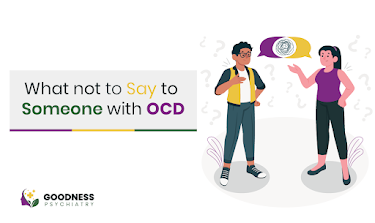What Are the Goals of Psychotherapy? A Comprehensive Guide
Psychotherapy, commonly referred to as "therapy," is a valuable tool for improving mental health and overall well-being. It involves various techniques and approaches designed to help individuals understand and manage their thoughts, feelings, and behaviors. But what exactly are the goals of psychotherapy, and how do different types of therapy work toward these goals? In this blog, we’ll explore the objectives of psychotherapy, the aims of specific therapeutic approaches, and provide a comprehensive overview of what you can expect from therapy.
What Is the Goal of Psychotherapy?
The goal
of psychotherapy can vary depending on the individual and the type of
therapy being used. Broadly, psychotherapy aims to help individuals improve
their emotional and psychological well-being, develop healthier coping
mechanisms, and enhance their overall quality of life. The objectives of
psychotherapy can be multifaceted and include:
- Understanding
and Insight: Gaining a deeper understanding of oneself, including
one's emotions, thoughts, and behaviors. This insight can help individuals
make sense of their experiences and identify patterns that may be
affecting their well-being.
- Emotional
Regulation: Learning to manage and regulate emotions more effectively.
This can involve developing strategies to cope with stress, anxiety,
depression, or other emotional challenges.
- Behavioral
Change: Modifying harmful or unproductive behaviors and developing
healthier habits. Therapy often focuses on changing maladaptive behaviors
that may be contributing to mental health issues.
- Improved
Relationships: Enhancing interpersonal skills and improving
relationships with others. Therapy can help individuals communicate
better, resolve conflicts, and build stronger connections with those
around them.
- Coping
Skills: Developing and strengthening coping mechanisms to deal with
life's challenges. This includes learning new strategies for managing
difficult situations and emotional responses.
- Self-Esteem
and Confidence: Building self-esteem and confidence. Therapy can
support individuals in recognizing their strengths and achieving a more
positive self-image.
Types of Psychotherapy and Their Goals
There are several types of psychotherapy, each with
its unique goals and techniques. Here’s a look at some common types and their
specific objectives:
- Cognitive
Behavioral Therapy (CBT) Goals
- CBT
focuses on changing negative thought patterns and behaviors. The goals
of CBT include identifying and challenging irrational beliefs,
developing healthier thinking patterns, and learning practical strategies
for managing stress and anxiety.
- Psychodynamic
Therapy Goals
- Psychodynamic
therapy aims to explore unconscious processes and how they influence
current behavior. Goals of psychodynamic therapy include gaining
insight into unresolved conflicts and emotional issues from the past,
improving self-awareness, and understanding how these issues affect
current relationships and behaviors.
- Humanistic
Therapy Goals
- Humanistic
therapy emphasizes personal growth and self-actualization. The types
of humanistic therapy include Gestalt therapy and Person-Centered
therapy. Goals of humanistic therapy include fostering
self-acceptance, promoting personal growth, and enhancing one's sense of
purpose and fulfillment.
- Behavioral
Therapy Goals
- Behavioral
therapy focuses on changing specific behaviors through conditioning
techniques. Goals of behavioral therapy include modifying
maladaptive behaviors, increasing adaptive behaviors, and using
reinforcement strategies to promote positive changes.
- Well-Being
Therapy Goals
- Well-being
therapy is designed to enhance overall life satisfaction and
happiness. Goals of well-being therapy include improving emotional
resilience, fostering positive emotions, and increasing overall
well-being and life satisfaction.
Examples of Psychotherapy Goals in Practice
To better understand the goals of psychotherapy, it
can be helpful to consider real-life examples. Here are a few scenarios
illustrating how therapy goals might be applied:
- Example
1: Managing Anxiety
- Goal:
Develop effective coping strategies to manage anxiety.
- Approach:
Using CBT techniques to identify and challenge irrational thoughts,
practice relaxation exercises, and gradually face feared situations.
- Example
2: Improving Relationship Skills
- Goal:
Enhance communication and conflict resolution skills.
- Approach:
Engaging in Humanistic therapy to improve self-awareness, practice active
listening, and develop healthier interpersonal skills.
- Example
3: Overcoming Depression
- Goal:
Alleviate symptoms of depression and improve mood.
- Approach:
Using Psychodynamic therapy to explore underlying emotional issues and
unresolved conflicts, combined with CBT techniques to challenge negative
thought patterns and promote positive behaviors.
What Are the Goals of Therapy?
In summary, the goals of psychotherapy are diverse
and tailored to the individual’s needs. Whether through psychodynamic
therapy goals, CBT goals, or other therapeutic approaches, the
ultimate aim is to support individuals in achieving greater mental and
emotional well-being. Therapy provides a space for self-exploration, skill
development, and personal growth, helping individuals navigate life’s
challenges and enhance their overall quality of life.
If you're considering therapy, it's important to discuss
your specific goals with a mental health professional. They can help you
understand which type of therapy might be most effective for you and work with
you to establish clear and achievable objectives for your therapeutic journey.

.jpg)

Comments
Post a Comment